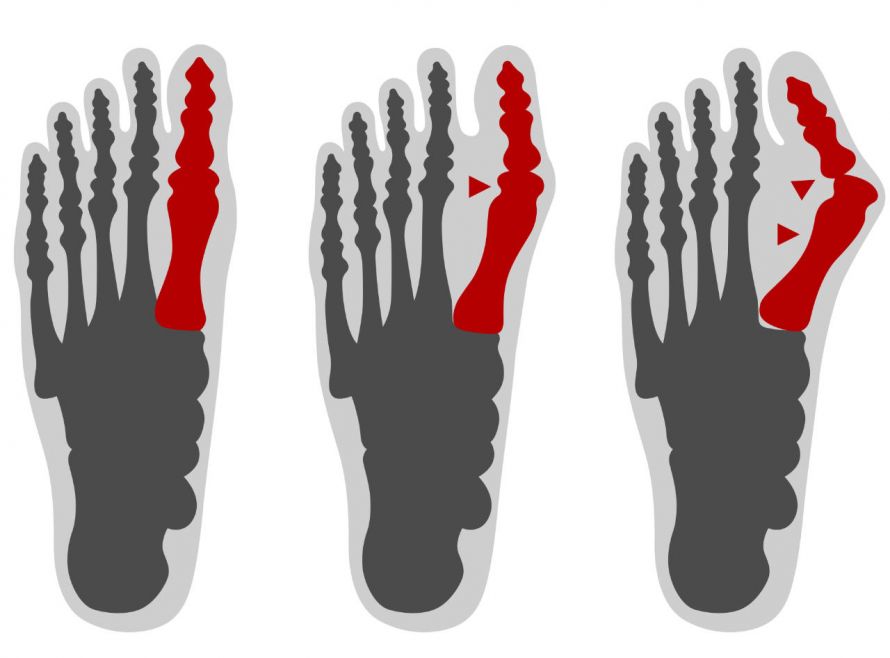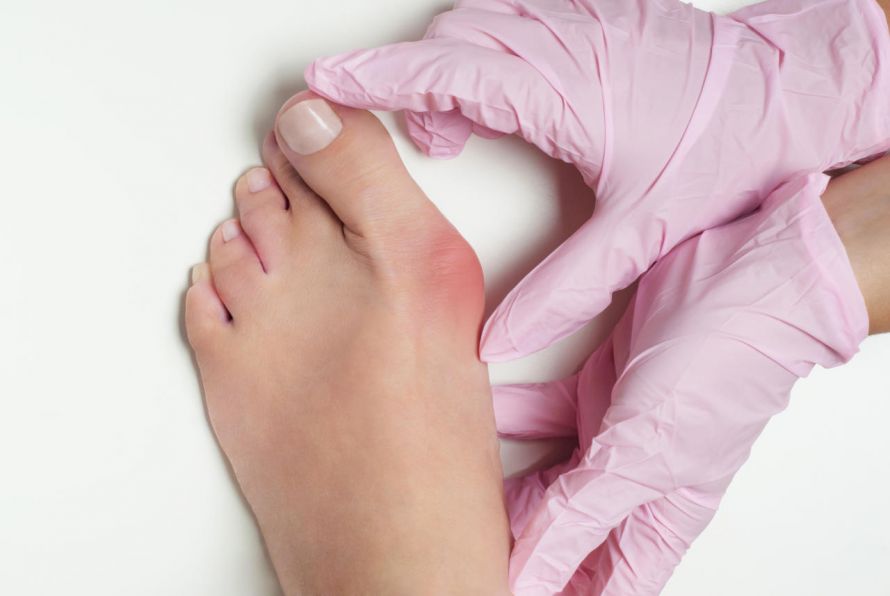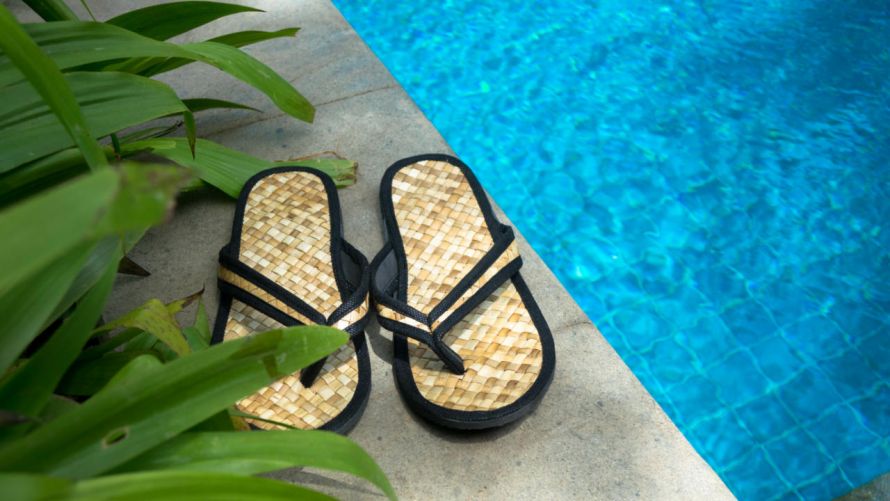Hallux valguas - also called bunion - is a painful malposition of the big toe. In Germany alone, over 10 million people suffer from it. Women are far more likely to be affected by hallux valgus, as the toe deformity is usually a result of shoes that are too tight and have a pointed toe. Here you will find further information and selected hallux valgus specialists.
Recommended specialists
Brief overview:
- What is hallux valgus? A common painful deformity of the big toe.
- Causes: Genetic predisposition can be the cause, but most often the condition develops throughout life as a result of wearing tight, pointed shoes that leave too little room for the toes. Therefore, women are affected significantly more often.
- Symptoms: The symptoms depend on the stage of the disease. Initially it is a cosmetic problem, but later on pain and joint wear develop.
- Diagnostics: Orthopedists can quickly recognize the diagnosis of hallux valgus, if necessary with the help of x-rays.
- Treatment: Orthopedic shoes, walking barefoot and foot gymnastics are recommended to avoid further stress on the toes. In severe cases, only surgery can provide relief, with the goal of restoring the natural position of the toes.
- Prevention: Wearing comfortable shoes that leave enough room for the toes is the best prevention. Walking barefoot frequently is the best option for the feet. Anyone who notices that the big toe is prone to deformity should see a doctor immediately to avoid it getting worse.
Article overview
Causes for hallux valgus
Many factors influence the development of hallux valgus. In some families, a pre-disposition can be observed. However, most cases are due to unhealthy footwear.
Mechanical irritation can occur, especially in shoes that are too tight and leave too little room for the toes in terms of width. In this case, the big toe is permanently pressed outward against the edge of the shoe. This permanent pressure leads to a chronic malposition of the bone and thus to hallux valgus. Changes to cartilage and tendons as well as inflammation can also result.

Development of the hallux valgus malposition: on the left healthy toe, on the right hallux valgus © barbulat | AdobeStock
Women are more likely to suffer from hallux valgus due to the shoe fashion in Western industrialized nations. In countries where open shoes or no shoes at all are worn, significantly fewer people suffer from hallux valgus.
A splay foot position can also promote the development of hallux valgus. In this case, too, the big toe is pressed toward the outer edge of the foot. The malpositions reinforce each other, so that both conditions - hallux valgus and splayfoot - require medical treatment.
People with weak connective tissue have a strong tendency to develop hallux valgus. The strength and elasticity of the connective tissue also decreases with age. The entire weight of the body rests on the feet. This pressure, in conjunction with incorrect weight bearing, can then lead to a widening of the foot's skeleton.
Hallux valgus symptoms
Symptoms vary and change over the course of the disease depending on the severity and stage of hallux valgus.
The big toe deviates outward from its base joint. At the beginning of the condition, hallux valgus is therefore predominantly a cosmetic problem.
In later stages, the other toes also deviate outward or can be overlapped by the big toe. The first painful symptoms occur on the inside of the first metatarsal.

High heels and pumps favor the development of hallux valgus © superelaks | AdobeStock
Finally, at the widest part of the foot, a painful bunion develops due to constant mechanical friction. This is caused, among other things, by inflammation of the bursa lying under the skin.
Furthermore, the base joint of the big toe gets worn out faster due to the malposition. This severely restricts the movement of the toe and increases the pain. The wear of the metatarsophalangeal joint of the big toe is referred to as metatarsophalangeal joint arthrosis or hallux rigidus.
In addition to the first toe (big toe), the second toe can also be affected by hallux valgus. In this case, the big toe partially or completely underlaps or overlaps the second toe.
In later stages, the other toes as well as the adjacent joints and the metatarsal bone are also affected. This leads to overstraining and painful symptoms (metatarsal
Externally visible symptoms here include, in particular, painful pressure calluses under the metatarsophalangeal joints of the small toes.
Diagnosis of hallux valgus
The toe deformity initially causes no pain and remains unnoticed. That is why hallux valgus is hardly ever diagnosed in the early stages.
The doctors to contact for a diagnosis are orthopedists or foot surgeons. First of all, the doctor asks about the patient's complaints during the medical history interview. He also asks about any known risk factors.
Hallux valgus can often be easily identified by visual diagnosis. In case of any doubts, an X-ray examination is required.

Hallux valgus can often be recognized immediately by looking at the bunion of the toes © luaeva | AdobeStock
Depending on
- manifestation,
- stage,
- complaints and
- and the associated pain,
the treating physician determines the therapy. A mildly pronounced hallux valgus can be treated with conservative therapy options.
In moderate to severe cases, the deformity should be corrected by surgery. According to the stages of hallux valgus, different surgical procedures must be used.
Treatment for hallux valgus
In the early stages, switching to comfortable, well-fitting shoes can help stop the deformity from getting worse. The affected person must then wear shoes that are neither too tight, nor too high, nor too short and leave plenty of room for the toes. Flipflops are a very popular form of footwear in this case.

Flipflops leave enough space for the toes © familie-eisenlohr.de | AdobeStock
Basically, a change to
- orthopedic shoes,
- barefoot walking and
- foot gymnastics
is highly recommended for hallux valgus. Conservative means such as foot gymnastics should be exhausted as long and extensively as possible.
A hallux valgus with advanced manifestation can no longer be reduced or stopped by wearing the right footwear. Instead, surgical therapy must be initiated.
Surgery always poses a certain risk. As with any surgical procedure, in some cases,
- bleeding,
- thrombosis,
- nerve injuries or
- infections
may occur.
In order to achieve the best and most lasting results, patients should consult an experienced orthopedic technician. In this respect, patients are in the best hands at foot surgery centers. Orthopedic technicians can optimize the healing process and help prevent hallux valgus from forming again.
Knowledge about hallux valgus surgery
Surgery for hallux valgus is relatively complicated. Earlier surgical procedures were primarily focused on straightening the malposition of the big toe again and "cutting away" the troublesome bunion. Today, the goal is to preserve the joint and restore the natural position as much as possible. To this end, different methods are used in an individual treatment concept, depending on the respective conditions.
In total, there are over 150 different surgical techniques for hallux valgus. In German-speaking countries, about 10 of these are in common use. The various hallux valgus surgeries can be divided into three different groups:
- mere soft tissue techniques (surgeries on soft tissues such as tendons and capsules),
- purely bony surgical techniques and
- combined bone and soft tissue correction procedures.
Hallux valgus surgery approach
Depending on the severity of the hallux valgus, it may be sufficient to remove the bony protrusion (exostosis removal) and realign the metatarsal (realignment osteotomy). A small titanium screw fixes the realignment. The screw usually does not have to be removed again. A special shoe must be worn until the healing is complete, which takes about four to six weeks.
Another option is a Z-shaped separation of the first metatarsal bone (osteotomy). This corrects and fixes the toe position. Healing after the operation takes about 6 weeks, during which a special shoe must also be worn. The load on the foot in this special shoe is not a problem.
In the severe form of hallux valgus, the angle between the first and second metatarsal is significantly increased. Here, the head of the first metatarsal bone protrudes strongly inward. One possible surgical method is to cut the metatarsal bone and make an adjustment at its base (adjustment osteotomy).
Almost all common surgical methods for hallux valgus consist of a separation of the metatarsal bone. They differ in the way the incision is made.
In most cases, surgery is performed during an inpatient hospital stay.
Possible complications of hallux valgus surgery
Patients receive comprehensive information about possible complications before the procedure. Complications such as
- bone infections,
- joint infections,
- nerve or
- vascular injuries
are rather rare.
In foot surgery, there is always an increased risk of thrombosis due to the prolonged immobilization of the leg during and after hallux valgus surgery. Therefore, preventive thrombosis prophylaxis takes place. The patient must administer certain injections for a certain period of time.
Follow-up care after hallux valgus surgery
Following this surgery, the patient should strictly follow the medical advice and instructions of the doctor. The focus is not only on healing, but also on preventing the recurrence of hallux valgus. The patient must consistently integrate the appropriate preventive and aftercare measures into everyday life and take them seriously.
Postoperative immobilization of the foot is important for healing. Putting too much stress on the foot too early could significantly worsen the long-term prognosis.
A period of being unable to work or do sports is indispensable after a hallux valgus surgery. Only after six months is sport possible again to the full extent. However, pain-free walking should be possible much earlier.
A special orthopedic dressing shoe is recommended for 6 weeks after surgery. After that, a specially adapted shoe should be worn for 3-6 months after surgery.
It is important that the patient also takes care of his feet long-term after the surgery. This also includes refraining from wearing high heels as much as possible.
As a rule, the same measures apply for successful therapy as for the prevention of hallux valgus:
- frequent barefoot walking,
- wearing comfortable (orthopedic) shoes,
- foot gymnastics and
- foot massages.
Despite all due diligence, an axial deviation can occur again after hallux valgus surgery. In rare cases, a second surgery is then required.
Prognosis after hallux valgus surgery
The long-term prognosis depends on the stage of hallux valgus at the time of diagnosis as well as its accuracy. The subsequently selected surgical method and the experience of the surgeon play an equally important role. In addition, the patient can influence the long-term outcome by consistently adhering to the postoperative guidelines.
If there is no advanced osteoarthritis in the metatarsophalangeal joint of the big toe, the healing process after surgery is good to very good in the majority of patients.
Prevention of hallux valgus
Since hallux valgus is often caused by incorrect footwear, the prevention strategy can be derived accordingly: High shoes, which are tight in the front, should be worn only rarely. It is recommended to wear varied footwear, then it usually does not come to malposition.
Wearing comfortable shoes with a good footbed that leave plenty of space for the toes at the front is an efficient preventive measure. Foot exercises are recommended to compensate for immobilizing feet in shoes. Massages and foot baths are also good for the feet.
Walking barefoot is also a good preventive measure against hallux valgus, as it is a kind of natural massage for the feet. When walking barefoot, the foot muscles are challenged in a completely different way than when walking in shoes.
So walk barefoot as often as possible to support natural toe and foot positioning!

Frequent barefoot walking is good for the feet © Halfpoint | AdobeStock
When to see a doctor?
Even if the malposition of the big toe is mild, it is advisable to consult a family doctor or orthopedist. Once hallux valgus is present, it is difficult to stop the process that has been set in motion.
If the malposition goes beyond a cosmetic deformation of the toe and is associated with pain, a specialist should be consulted urgently.
The pain could be alleviated by appropriate adjustments of footwear, etc. However, a cure of hallux valgus is only possible after a foot surgeon corrects the deformity during a surgical procedure.
























